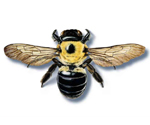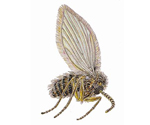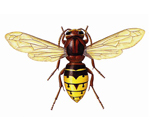Bees, Hornets, Wasps, Flies & Mosquitoes

Cluster Flies (Pollenia Rudis): Size: 5/16” long color: non-metallic, light & dark grey abdomen In the late fall, cluster flies will fly to the sunny sides of homes and other structures in search of protected sites to over-winter. They will migrate inside through cracks and crevices and as the temperature drops they will remain in a semi-dormant state until warmed by heat from the sun. They can often be found in great numbers in wall-voids, attics and other inaccessible areas. After emerging in the spring, they are frequently found sluggishly buzzing around windows.To control these annoying pests, call our experts at (781) 599-4317.

Carpenter Bees: In the late-spring and early summer, homeowners often notice large, black bees hovering around the outside of their homes. These are probably carpenter bees searching for mates and favorable sites to construct their nests. Male carpenter bees are quite aggressive, often hovering in front of people who are around the nests. Although carpenter bees are less aggressive than wasps, female bees provisioning their nests will sting.Carpenter bees drill a perfectly round 1/2 inch diameter hole into the wood. They frequently drill into bare unfinished wood including eaves, window trim, fascia boards and decks. After drilling a hole against the grain, the bee turns at a right angle and tunnels along the grain of the wood. Over time, these bees will cause considerable damage.
For prompt control of these damaging pests call our experts at
(781) 599-4317.

Drain Flies: Drain flies are a common, Major health hazard. These small insects closely resemble fruit flies and breed in the decaying organic matter typically found in “J” traps or floor and sink drains. Drain flies cannot be eliminated unless you remove their food source and egg laying environment.

European Hornet: They are about 5/8 to 3/4+ inch in length, the queens are generally a little larger. They are mostly black with a white pattern on most of the face, and a few white markings on their body. The inseminated queen uses chewed up wood fibers to build a paper nest. Eggs are laid in the cells, as the eggs hatch, the larvae are fed by the queen. As the colony grows, the workers take over enlarging the nest and feeding the larvae, leaving the queen to produce eggs.

Fruit Fly: Adults are about 1/8 inch in length and the color varies between tan, brownish, or brownish-black. The eyes are normally bright red. Fruit flies are drawn to fresh fruit and vegetables or where there is plenty of moisture and yeast.

House Fly: The house fly is the most common of all flies fluttering in homes, and indeed one of the most widely distributed insects; it is often considered a pest that can carry serious diseases. Its eggs are laid in almost any moist and warm material such as manure, decaying vegetable material and garbage.

Mosquitoes: The females of most mosquito species suck blood from other animals, which has made them the most deadly disease vector known, killing millions of people over thousands of years and continuing to kill millions per year by the spread of diseases.Most species are nocturnal or crepuscular (dawn or dusk) feeders. During the heat of the day most mosquitoes rest in a cool place and wait for the evenings. They may still bite if disturbed. Mosquito’s are adept at infiltration and have been known to find their way into homes via deactivated air conditioning units.

Paper Wasp: Adults are about 5/8-3/4 inch long. They are usually brownish with yellow markings, and some have been known to have reddish markings. Paper wasps will hang their comb nests from branches, twigs and shrubs. Most often, if these nests are approached or tampered with they will sting.
